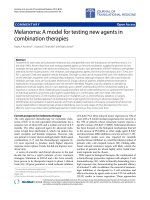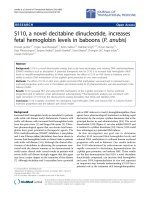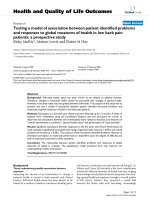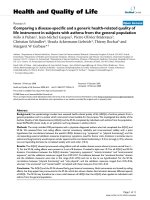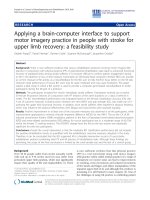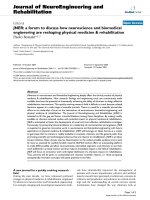Báo cáo hóa học: " Frag-Virus: a new term to distinguish presumptive viruses known primarily from sequence data" pdf
Bạn đang xem bản rút gọn của tài liệu. Xem và tải ngay bản đầy đủ của tài liệu tại đây (139.69 KB, 1 trang )
BioMed Central
Page 1 of 1
(page number not for citation purposes)
Virology Journal
Open Access
Debate
Frag-Virus: a new term to distinguish presumptive viruses known
primarily from sequence data
Alexander Voevodin*
1
and Preston A Marx
2
Address:
1
Vir&Gen, Toronto, Canada and
2
Division of Microbiology, Tulane National Primate Research Center, Covington, Louisiana USA
Email: Alexander Voevodin* - ; Preston A Marx -
* Corresponding author
The wide availability of PCR-based methods for the
amplification of nucleic acids homologous to known viral
genomes plus automated DNA sequencing have led to
explosive growth of a new field, 'proxy' virus isolation.
Typically, genomic fragments are amplified and subjected
to phylogenetic analysis showing that they are related to,
but distinct from, known 'bona fide' viruses. These "new
viruses" are now commonly reported in the virological lit-
erature and are too numerous to cite here, two studies are
given as typical examples [1,2]. Although unintentional,
these reports may, mislead the readership of scientific
journals and the general press. Having no distinction
between preliminary genome-based evidence and conclu-
sive proof by biological isolation and characterization of
a replication-competent virus blurs the meaning of new
virus.
To distinguish presumptive viruses known primarily
through genomic sequence fragments from bona fide
viruses we propose the term 'frag-virus'.
The 'frag-virus status' may be intermediary between 'full'
recognition as a new virus, as occurred, for example, with
hepatitis C virus and Kaposi sarcoma herpesvirus [3-6].
Frag-virus designation may also be a category for such
virus that likely exists, but there is neither sufficient moti-
vation nor resources to pursue its elevation from frag-virus
limbo to bona fide virus status. At the same time the frag-
virus status will be a 'career end-point' for sequences
belonging to non-infectious 'pseudo-viruses' or those hav-
ing their origins in artifact.
Whatever the 'fate' of frag-viruses, this simple term is
highly informative and may prove useful in preventing
misconceptions about new viruses.
References
1. Keele BF, Van Heuverswyn F, Li Y, Bailes E, Takehisa J, Santiago ML,
Bibollet-Ruche F, Chen Y, Wain LV, Liegeois F, Loul S, Ngole EM,
Bienvenue Y, Delaporte E, Brookfield JF, Sharp PM, Shaw GM, Peeters
M, Hahn BH: Chimpanzee reservoirs of pandemic and nonpan-
demic HIV-1. Science 2006, 313:523-526.
2. Van Heuverswyn F, Li Y, Neel C, Bailes E, Keele BF, Liu W, Loul S,
Butel C, Liegeois F, Bienvenue Y, Ngolle EM, Sharp PM, Shaw GM,
Delaporte E, Hahn BH, Peeters M: Human immunodeficiency
viruses: SIV infection in wild gorillas. Nature 2006, 444:164.
3. Choo QL, Kuo G, Weiner AJ, Overby LR, Bradley DW, Houghton M:
Isolation of a cDNA clone derived from a blood-borne non-
A, non-B viral hepatitis genome. Science 1989, 244:359-362.
4. Choo QL, Richman KH, Han JH, Berger K, Lee C, Dong C, Gallegos
C, Coit D, Medina-Selby R, Barr PJ: Genetic organization and
diversity of the hepatitis C virus. Proc Natl Acad Sci USA 1991,
88:2451-2455.
5. Chang Y, Cesarman E, Pessin MS, Lee F, Culpepper J, Knowles DM,
Moore PS: Identification of herpesvirus-like DNA sequences
in AIDS-associated Kaposi's sarcoma. Science 1994,
266:1865-1869.
6. Russo JJ, Bohenzky RA, Chien MC, Chen J, Yan M, Maddalena D, Parry
JP, Peruzzi D, Edelman IS, Chang Y, Moore PS: Nucleotide
sequence of the Kaposi sarcoma-associated herpesvirus
(HHV8). Proc Natl Acad Sci USA 1996, 93:14862-14867.
Published: 27 February 2008
Virology Journal 2008, 5:34 doi:10.1186/1743-422X-5-34
Received: 18 February 2008
Accepted: 27 February 2008
This article is available from: />© 2008 Voevodin and Marx; licensee BioMed Central Ltd.
This is an Open Access article distributed under the terms of the Creative Commons Attribution License ( />),
which permits unrestricted use, distribution, and reproduction in any medium, provided the original work is properly cited.


